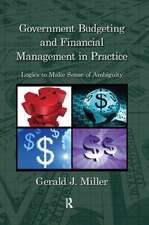Deficit: Why Should I Care?
Autor Marie Bussing-Burksen Limba Engleză Paperback – 30 oct 2012
This clear, concise book will give you the need-to-know on the debt. You will learn:
- How to calculate deficits and the national debt
- The history of U.S debt and its recent unparalleled growth over the years
- How and why the government borrows money
- The economic arguments for, and against, accruing a debt
- Could we become like Greece if we don't cut our deficit?
- The impact of the debt on interest rates and inflation
- The impact of the debt on the value of the dollar and U.S. economic power
| Toate formatele și edițiile | Preț | Express |
|---|---|---|
| Paperback (2) | 142.86 lei 22-36 zile | |
| Apress – 19 iul 2011 | 142.86 lei 22-36 zile | |
| Apress – 30 oct 2012 | 143.49 lei 22-36 zile |
Preț: 143.49 lei
Nou
Puncte Express: 215
Preț estimativ în valută:
27.46€ • 28.74$ • 22.72£
27.46€ • 28.74$ • 22.72£
Carte disponibilă
Livrare economică 17-31 martie
Preluare comenzi: 021 569.72.76
Specificații
ISBN-13: 9781430248392
ISBN-10: 1430248394
Pagini: 156
Ilustrații: XIX, 156 p.
Dimensiuni: 178 x 254 x 9 mm
Greutate: 0.24 kg
Ediția:2nd ed.
Editura: Apress
Colecția Apress
Locul publicării:Berkeley, CA, United States
ISBN-10: 1430248394
Pagini: 156
Ilustrații: XIX, 156 p.
Dimensiuni: 178 x 254 x 9 mm
Greutate: 0.24 kg
Ediția:2nd ed.
Editura: Apress
Colecția Apress
Locul publicării:Berkeley, CA, United States
Public țintă
Popular/generalNotă biografică
Marie Bussing-Burks is an assistant professor of economics at the College of Business of the University of Southern Indiana, where she teaches economics, focusing on microeconomics, macroeconomics, history of economic thought, and money and banking. She holds a master's degree in business administration and a doctorate of arts in economics. Bussing-Burks is the author of The Young Zillionaire's Guide to Taxation and Government Spending (2000), Profit from the Evening News: Using Leading Economic Indicators to Make Smart Money Decisions (2001), Influential Economists (2003), Money for Minors: A Student s Guide to Economics (2008), and Starbucks: Corporations that Changed the World (2009). She has more than 30 newspaper, magazine and journal articles to her credit. Bussing-Burks serves on the boards of the USI Foundation, Evansville Commerce Bank, and St. Mary's Health System.
Caracteristici
Deficit: Why Should I Care? Second Edition) explains the implications of one of the biggest (if not the single biggest) economic concerns of our time—the burgeoning $15 trillion American national debt and accompanying record-breaking deficits.


















